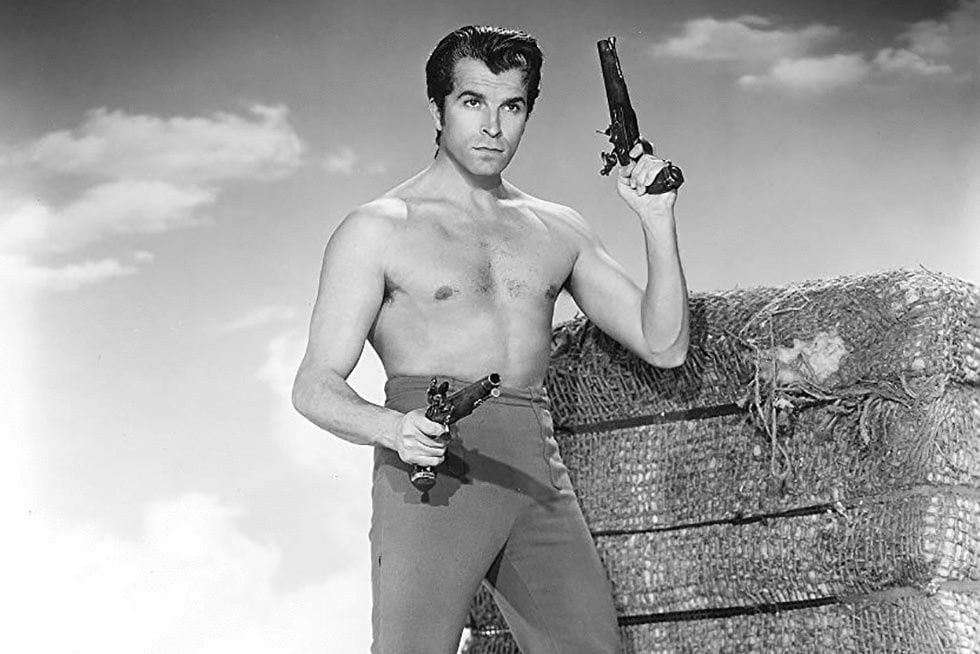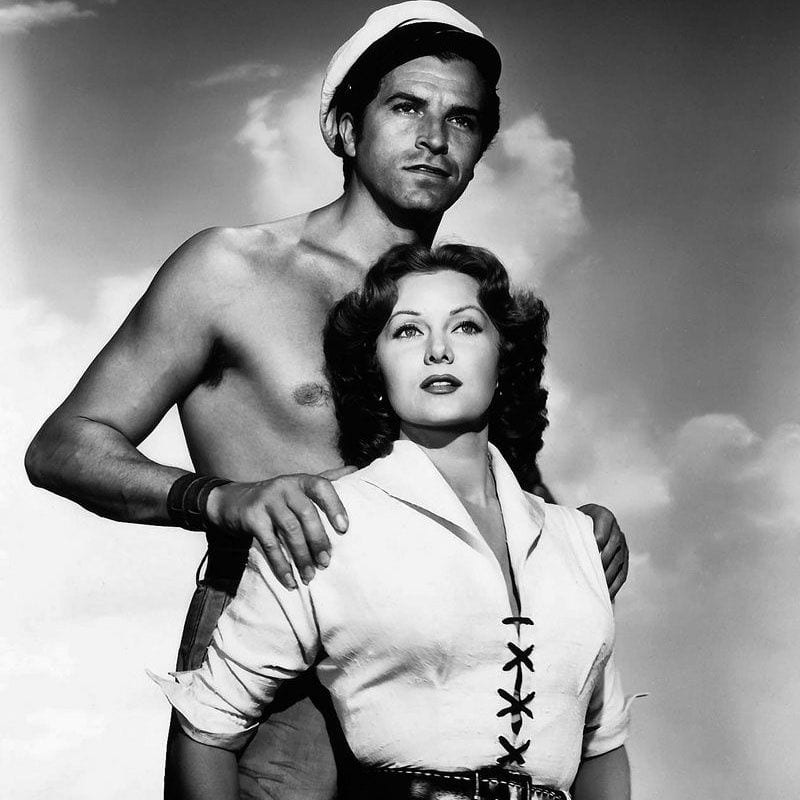

Fernando Lamas shines, perspires and bleeds in two films made in color and 3-D, as restored by the 3-D Film Archive for Kino Lorber Blu-rays. Although neither Sangaree (1953) nor Jivaro (1954) has any particular reputation, both are at least entertaining and Sangaree is rather better than that.
After becoming a star in his native Argentina, Lamas came to Hollywood under MGM contract. He was their second “Latin lover” import following their success with Mexican star Ricardo Montalban, and both men played opposite Esther Williams. Lamas would eventually marry her. Although he spent the bulk of his career on TV and became a busy director in that medium, he will always be remembered for the suave and handsome “lover” persona he passed on to son Lorenzo Lamas, and which was parodied by Billy Crystal’s SNL character, Fernando, who told everyone “You look mah-velous!”
Lamas certainly looks mah-velous in Sangaree, when he was loaned to Paramount for what turned into its first 3-D production. The story begins just as news of the British surrender has won independence for America, which would make it 1783. Dr. Carlos Morales (Lamas) rushes to the deathbed of General Darby (Lester Matthews) to be informed that the dying general wants Morales to supervise the general’s Georgia estate of Sangaree and carry out his various wishes.
These plans include building a public hospital and a school to educate the children of indentured servants and slaves, and an estate that will only employ free men and bondsmen who may receive wages toward buying out their servitude, because “free men work harder than slaves”. Morales himself is the son of an indentured servant and has been educated in Vienna at the general’s expense.
Darby sounds not only progressive but radical, which is why he’s denounced in court as a lunatic who would undermine the state’s economic system. It all sounds like a beautiful dream instead of a history lesson, and indeed the dialogue jumps the gun historically at certain points, as when it’s claimed that the British surrender has created one country called the United States of America. Not so fast, it didn’t.
I have a theory that foreign-born directors in Hollywood had a greater tendency to present African-American characters, such as the sundry servants in this plot, in a natural way without putting on obsequious or comical accents or behavior, and that’s born out in this film directed by the Russian-born Edward Ludwig. More significantly, there’s dialogue making it plain that a character we might presume is a slave actually isn’t. “I’m a freedman, sir. I work where I am paid,” says Priam (William Walker), who will become more important to the plot than supposed.
Apart from the strikingly benign politics and class-consciousness in this story, which includes an antagonist who’s illegally smuggling slaves (although slavery is legal!) and literally as well as metaphorically poisoning the town with plague, the complicated plot involves strife between Carlos and the general’s daughter, the fiery and tempestuous Nancy Darby (Arlene Dahl). While they’re at it, in comes a subplot about Carlos’ old girlfriend Martha (Patricia Medina), who doesn’t see why her marriage to Nancy’s brother (Tom Drake) should spoil a good thing.
David Duncan’s script, based on Frank Moss’ adaptation of Frank G. Slaughter’s novel, is unusually elegant and intelligent of dialogue and adroit in its construction of a complicated story with many elements and characters, including plenty we haven’t mentioned. Significant supporting roles go to Francis L. Sullivan as a pompous snuffy aristocrat, John Sutton as his nasty son, Charles Korvin as a dapper and clever Frenchman who may be a pirate, Willard Parker as the hero’s upstanding chum, and Charles Evans and Roy Gordon as local fuddy-duddies. The story encompasses plagues, duels, fires, trials, betrayals and the inevitable old-fashioned barfight.
While all this is much smarter and more carefully arranged than we’d have a right to suppose from what’s packaged as a sultry bodice-ripper, we must admit the main attraction is the bodice-ripping and the beautiful design and colors, from Edith Head’s costumes of silken frippery and foppery to the handsome sets. The vivid colors, beautifully restored here, were shot in Eastmancolor and developed by Technicolor in creamy, dreamy pastels. The photography by Lionel Lindon and Wallace Kelley emphasizes elegance over throwing things at the audience’s head for 3-D antics, though there are a few examples of that.
Even the romance between a couple initially at odds is handled in a much less tiresome manner than is typical. Lamas and Dahl generate real heat from their first encounter, when she’s barefooted and he’s bare-chested and both characters indulge in details of sado-masochism. Their eyebrows speak louder than words. (The actors were married for several years, and Dahl is Lorenzo’s mother.) The third time Carlos meets Nancy, his shirt is in shreds with prominent streaks of blood, causing her to ask, “Is it always your custom, Dr. Morales, to greet women while you’re half naked?” Someone clearly found this a good idea, for, as we shall see, Jivaro is structured entirely on that proposition.
Jivaro (1954) is a horse of a different Technicolor in that Paramount’s powers that be, or powers that were, decided not to release it in 3-D after all, despite the unusual care taken with the process. Its 3-D debut occurred in 2006. Therefore, this restoration constitutes the first time that any sizable audience (with the proper equipment) will be able to take it in.
What they’ll find is a movie superficially about many things, but the overriding central visual idea of this spectacle is how to organize scenes around Lamas in various states of un-shirtedness. Just as the shot list and the interaxial specifications were carefully planned in advance, as explained in the expert commentary, so were the filmmakers clearly concerned with modulating Lamas’ variations according to partly unbuttoned, fully unbuttoned, and freely torso-ed. The whole matter was executed symphonically and made clear in the poster, whose promises for once went fulfilled.
As Rio Galdez, Lamas spends the movie not only unbuttoned or shirt-free, but most often with a prominent black holster and pistol fastened to the front of his bluejeans. He often has a jaunty captain’s cap and, when bare-headed, lets his cowlicked pompadour wave proudly as he strides about the place, now brooding, now smoldering. He even gets a shower scene. Mind you, his vibrantly red-headed co-star Rhonda Fleming, God’s gift to Technicolor, gets to wander around in a slip on a couple of occasions and once only in a towel, but Lamas keeps stealing her statuesque thunder because, at the end of the day, it’s his picture and he’s front and center making everything happen.
As a character, Rio’s conceived to remind viewers of a combination of two Humphrey Bogart roles. As a trader who runs a dilapidated boat up and down the Amazon and gets saddled with an inconveniently upper-class female passenger with whom he’ll fall in love, he’ll have reminded 1954 audiences of Bogart’s Oscar-winning role in John Huston’s The African Queen (1951). As a man who also owns a self-named trading post that functions as a nightclub, complete with piano, to which everybody goes, he’ll remind viewers of the sexier Rick in Michael Curtiz’s Casablanca (1942), especially when he asks “Why should I stick my neck out?”
Rio trades useless knick-knacks to the Jivaro head-hunters in return for rubber and animal hides, and if that’s not already a sufficient demonstration of capitalism, he discovers that his jolly supplier (Lon Chaney Jr. in a cameo) has loaded two crates with rocks to further the swindle. No wonder relations are fraught, and we can’t blame the Jivaros for being disgusted with foreign greed, which will be the motivating conflict of the final reels. Strangely, the Jivaros (led by Marvin Miller) all seem to be middle-aged and flabby. Maybe their youngsters have all gone to the city, or maybe nobody wanted Lamas to have competition.
Fleming drops in as Yankee bombshell Alice in search of her alleged boyfriend (Richard Denning), who’s been spinning her yarns of working on a plantation while, in fact, he spends his days drinking himself into a stupor, wenching with a local gal (Rita Moreno in an early role), and pursuing rumors of Jivaro gold hidden in a temple in the Valley of the Winds. He’s a classic ugly colonialist, gone to the dogs and bedeviled by visions of plunder, and Alice must be weaned from delusions in favor of the hard-working Latin-American who respects the natives. If you really examine the subtexts, the story holds up fairly well for today’s sensibilities. Perhaps these ideas originate in the story credited to the same Duncan who scripted Sangaree, though this time Winston Miller wrote the script.
The main antagonist is another greedy American gold-hunter (Brian Keith) who tries to trick Alice into spending the night at his camp, leading to a big bout of 3-D-conscious fisticuffs with Rio. For the last act, they all trek into the jungle in search of the missing useless boyfriend and his reputed gold stash, and we have more “comin’ at ya” business with flaming arrows and spears and whatnot until the metaphorical cavalry show up and wreak more havoc with Jivaro relations.
The central characters live or die according to a moral calculus of worthiness, which conveniently includes the most beautiful. If we haven’t made it clear, this is very much a movie about heat and flesh, and really the whole stew — like that semi-indigestible ration of beans and we-don’t-know-what rustled up by Rio in a scene of comic relief — is about nothing more or less than bringing these two most stunning specimens into close proximity and letting them simmer until ready to melt into each other. This is why the shirtless factor has determined all.
Ludwig, whose career went from silent comedy shorts to B pictures to TV westerns, directed both pictures for Pine-Thomas Productions, a very profitable Paramount B-unit run by William C. Pine and William Thomas, who were known as “the Dollar Bills”. Since the early ’40s, its budget-conscious programmers delivered two-fisted he-men in plenty of action. After a decade of such shenanigans, which tended to blur into each other with the same casts and crew, competition from TV and changing markets caused them to raise their budgetary game with more ambitious productions, of which these forays into 3-D and Technicolor are examples.
Although the films still tended to be two-fisted and formulaic, Pine and Thomas produced so many that they almost couldn’t help now and then fashioning something unusual and memorable, like Maxwell Shane’s nightmarish noir Fear in the Night (1947) and its remake, Nightmare (1956); Joseph Losey’s study of anti-Mexican prejudice and mob violence, The Lawless (1950); Rudolph Maté’s picturesque Lewis & Clark adventure, The Far Horizons (1955); and Nicholas Ray’s western bromance Run for Cover (1955).
Sangaree deserves to be mentioned with those highlights, while Jivaro is a reasonable and well-constructed example of a type of sexy, shameless pulp adventure typical of the era. Lionel Lindon’s photography combines Paramount’s jungle lot with matte work and bits of Florida second-unit shots. Both films use much the same crew, including Head providing Fleming’s multiple changes of wardrobe in her jungle spree. One curious detail of both films is an Intermission card, something we’ve never seen on any American films only about 90-minutes in length. These weren’t roadshow epics.
Sadly, we don’t have 3-D equipment and can’t report on how good the films look in that regard. It’s fortunate that the discs detect what’s necessary and automatically default to the 2-D versions for normal play; in other words, the “right eye” print only instead of both prints layered on each other. In any event, both films are staged so clearly and vividly that even the flat versions sometimes look like they’re “popping” with their varying planes.
Both Blu-rays, which are aimed squarely at the 3-D enthusiast, come equipped with extras that focus on the technical aspects of this process, how the movies were filmed, and how the restorations were handled by the folks at the 3-D Film Archive. Jivaro includes a technical commentary, while Sangaree throws in a radio adaptation of the same story and impressive before-and-after footage of the restoration. Jivaro footnotes the interaxial data for one section of the film on a shot-by-shot basis.
3-D Film Archive seems dedicated to preserving the whole slew of ’50s-era stereoscopic productions. We wish it well on this worthy goal. If you care about 3-D history, or about Lamas, or about how far the ’50s could push erotic buttons (or un-buttons) within family entertainment, you’ll have a good time here.
- Edward Ludwig - IMDb
- Jivaro 3-D (Blu-ray) - Kino Lorber Studio Classics
- Jivaro - 3dfilmarchive
- Jivaro (film) - Wikipedia
- Jivaro (DVD) - Kino Lorber Home Video
- Jivaro 3-D (Blu-ray) - Kino Lorber Home Video
- Jivaro (1954) - IMDb
- Sangaree 3-D (Blu-ray) - Kino Lorber Home Video
- Sangaree by Edward Ludwig |Edward Ludwig, Fernando Lamas ...
- Sangaree (film) - Wikipedia
- Sangaree (1953) - IMDb



